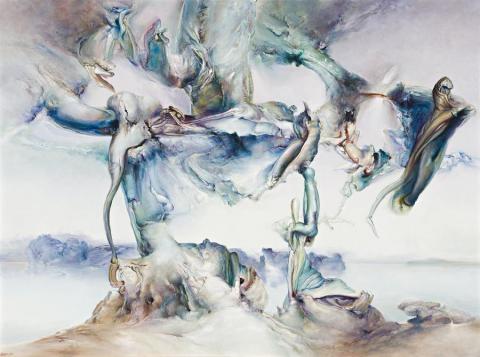THE IDIOM OF PENDING ISLANDS, 1990
JAMES GLEESON
oil on canvas
172.0 x 230.0 cm
signed and dated lower left: Gleeson ‘90
signed and titled verso: “THE IDIOM OF PENDING ISLANDS” / James Gleeson
Lauraine Diggins Fine Art, Melbourne (label attached verso)
Private collection, Melbourne
The Idiom of Pending Islands is a masterful example of James Gleeson's fully evolved, large scale surrealist landscape painting of the 1980s. By this period he jettisoned all interest in the representation of the figure in the natural world as we know it and instead became transfixed with the protean landscape and life forms as they may have existed before civilisation, or as they might be in the imagined world after the obliteration of humanity. Gleeson himself commented, 'I got to the point where the extreme almost came to be recognisable - then I felt no need to use the form at all as an entirety. It could be represented by an arm, a hand, an eye. I broadened it to be not only landscape but cosmic experience.'1 The title of this work itself reflects this intangible but imagined sense of a reality yet to fully take shape.
Gleeson was without doubt Australia's leading surrealist painter and he remained steadfast in his commitment to the philosophy underpinning this international movement throughout his career. The 1980s were a particularly creative and productive period for Gleeson and the works from this time often featured the recurring motif of the mutable, transforming landscape as it merges with the ocean. They are in many ways an exploration into the subconscious mind as much as imaginings of the past and future, hence the common presence of the ocean and bodies of water in these works. The sea has been a poignant symbol of the unconscious since Greek mythology and the organic merging of body forms and landscape in The Idiom of Pending Islands harks back to the mutable shape changing sea god Proteus, son of Poseidon. His inextricable link to the ocean made him a symbol also of the unconscious. In fact, Carl Jung defined Proteus as the personification of the unconscious. Gleeson most certainly understood these links between psychoanalysis and mythology and throughout this series of works we find rich panoply of shape changing, protean forms in the process of transformation as they merge with sea, sky and land.
1. Free, R., James Gleeson: Images from the Shadows, Craftsman House, Sydney, 1993, p. 34
LARA NICHOLLS
